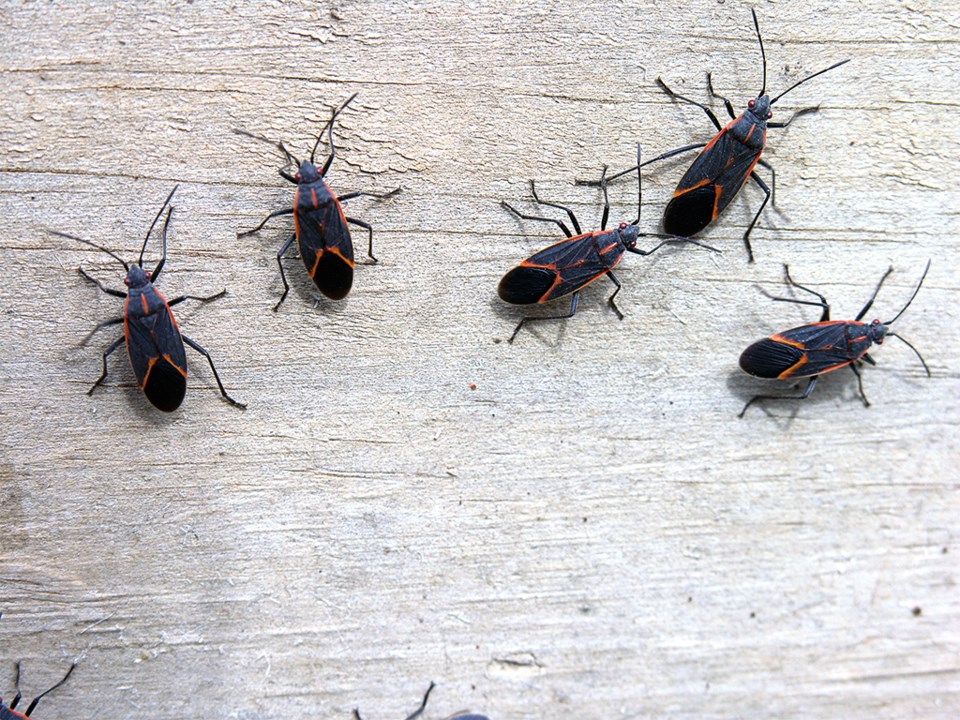REGINA — Maple bugs are a common sight in western Canada throughout the year and become particularly conspicuous in the late summer and early fall. Large aggregations of these insects are common on sunlit surfaces and if given the opportunity, can be a nuisance in houses.
Although the term “maple bug” is often used in Saskatchewan, the accepted, common name is boxelder bug. These are named for their preferred host plant, boxelder, Acer negundo, also called Manitoba maple and ashleaf maple. There are two species of this insect in Canada: the boxelder bug, Boisea trivittata, and the western boxelder bug, B. rubrolineata. Each is more prevalent on either side of the Rocky Mountains and there is some evidence that these may be the same species, despite some subtle differences in morphology.
These insects are members of the Rhopalidae, or scentless plant bugs family, though they are known for their displeasing smells. Phopalidae are part of the order Hemiptera, or true bugs. They are piercing-sucking feeders, meaning that they pierce their food with heavily modified mouthparts and suck out the liquid. Boxelder bugs feed almost exclusively on the developing seeds of Acer species but will also consume other insects. Their feeding is rarely damaging to host trees.
Adults overwinter in sheltered spots, sometimes in great numbers. These emerge in the spring to feed on fallen seeds and other insects in leaf litter and soil and developing buds on host trees. Eggs are laid on these trees. Highly conspicuous, bright red nymphs complete development to adulthood by mid-summer. These mate on flowering trees and can produce a second, overlapping generation. Come late summer, large aggregations form, mediated by release of male-and female-produced aggregation pheromones and attraction to warm, sunny sites.
One question asked is why they sunbathe. In addition to the pheromones released to facilitate mating and gathering, they also release monoterpenes from specialized glands. These substances make the insects distasteful to predators and can result in a pungent smell from crushed insects. These substances, the ultraviolet light and increased body temperatures associated with sunlight also reduce germination of the spores of an important insect pathogen, Beauvaria bassiana. It is thought that these monoterpenes are acquired by the bug from its host plant and that the red colouration is a sign of chemical defence.
Early fall is when boxelder bugs become a nuisance. They seek sheltered spots to overwinter and can squeeze through tight openings to get to them. This includes window and door seals, vents, and other holes in structures. They aren’t blood feeders or dangerous to humans or animals but can be problem roommates. Once inside a dwelling, they can stain surfaces with their feces and contribute to an unpleasant home experience. The best way to prevent entry is exclusion. Seals and screens that are in good repair are the most effective way to keep them out. Control with insecticides applied to surfaces and host trees is generally not effective.
Though a nuisance, they won’t be going away any time soon. If steps to exclude these insects from structures are taken, they can be an interesting component of gardens and yards and provide valuable information on aspects of chemical communication among insects.
— James Tansey PhD, AAg, Provincial Insect and Vertebrate Pest Management Specialist
Bookmark SASKTODAY.ca, Saskatchewan's home page, at this link.




